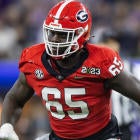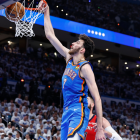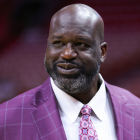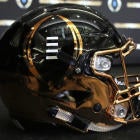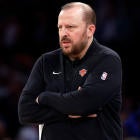BIRMINGHAM, Ala. -- This is what the death of a college football program looks like.
Despondent players collapse in the arms of a team chaplain. Irate players challenge the university president for specific answers. A couple hundred supporters chant and cheer for the coach, and then heckle and chase after the president and his police escort.
The band played, tears flowed, and football died Tuesday at the University of Alabama at Birmingham. It was 24 years old. Cause of death: Lack of investment, fiscal responsibility or political pettiness, depending on which obituary you read.
The rifle and bowling teams got buried, too. They got caught in the crossfire of UAB's decision to become the first university to drop a Football Bowl Subdivision/Division I football program since Pacific in 1995.
Pacific and UAB are bookends in history. Back in 1995, Pacific cited a $400,000 shortfall in its athletic budget as the reason to end football. On Tuesday, UAB produced a 16-page strategic planning report that projected the university would need to invest at least another $49 million over the next five years to keep football competitive.
"I know why it happened and you do too," said Dusty Davis, UAB's team chaplain. "That's one of the real sickening things is two or three people would have such a ripple effect on so many lives and so many really good kids."
UAB is overseen by the University of Alabama System Board of Trustees. The very strong belief by UAB supporters is football got killed by powerful trustees with Crimson Tide ties, including Paul Bryant Jr., the son of the legendary Alabama football coach.
"Let me make it very clear: The board of trustees had no role in the strategic plan," UAB president Ray Watts said.
The emotions were raw on a day that felt like a funeral.
"Some of these cats came from 3,000 miles away to play here, to be a part of this, to be a part of all of this!" UAB tight end Tristan Henderson hollered at Watts during his meeting with the team. "But you say numbers? That's what you come here to say, numbers?"
UAB went 10 years without being bowl-eligible until posting a 6-6 record this season under first-year coach Bill Clark. The program had been dumped on locally and nationally, but now there had been a glimmer of hope.
According to people in the meeting, players questioned Watts how other schools could make football work financially but UAB can't. Players told Watts they're more than a study. They accused him of lying to UAB's coaches. They asked him where has his support been.
"He was vague. He didn't show any emotion," UAB running back Ja'Won Arrington said. "Then he's gonna give us a bad excuse talking about you don't know what you don't know? What kind of answer is that? Explain to us. You can't even give us a clear, definite answer. All you can do is come in here and say you've supported us when you haven't."
The financial numbers
This is what the death of a college football program looks like.
The president says this wasn't the outcome anyone wanted but the numbers are the numbers. The athletic director who led the strategic study gets a new job title and is nowhere to be found. Reporters grill the president on what this really is all about and when the decision was made.
UAB said it already subsidizes $20 million of the roughly $30 million annual athletic department operating budget. The university cited continually spiraling athletic costs in college sports, including cost of attendance stipends to players. UAB's strategic report by consultant Bill Carr listed UAB's cost of attendance figure at about $5,442 per scholarship.
Carr's report forecast UAB's expenses with football increasing from $30.2 million in 2015 to $38.5 million in 2019 while generated revenue is expected to grow by less than $1 million. UAB is committed to providing institutional support of $14.5 million annually, along with student fee increases of 3 percent per year, the report said.
In a statement on Dec. 5, UAB said the Carr report "makes a planning assumption that tuition and fees will escalate at an inflationary rate of 3 percent per year. In reality, tuition and fees are decided on a year-to-year basis, and the rate for the 2016 academic year has not been established." UAB said its athletic department currently receives approximately $5.5 million from student fees.
Carr calculated the cumulative net deficit at $25.3 million over the next five years. Without football, Carr predicted a five-year net revenue of $2 million and the difference in operating expenses would be $27.3 million over five years with football.
On top of that, UAB determined it needed an incremental capital investment of $22.2 million in football facilities (outdoor practice field, multisport indoor practice facility and a football administration building) to sustain competitiveness. In other words, UAB argued, it needed to invest about $49 million over the next five years to be competitive in Conference USA.
As part of the strategic plan, UAB asked its coaches months ago what it needed to be competitive. Essentially, those responses then got used against the sports that got cut.
"We've never had this kind of plan before," Watts said in justifying UAB's unique position. "We've always run a deficit, and we've always added a little more thinking that would make the difference."
Reporters pressed Watts on how candid he was with Clark, who left a job last January with an FCS national championship contender at Jacksonville State to join UAB.
"I will tell you very straightforwardly we were as candid as possible with Coach Clark," Watts said. "We told Coach Clark that we were about six weeks into a strategic planning process for athletics in which we were going to look at everything. ... Everything was on the table. And he clearly understood that."
Clark did not respond to requests for comment. He said in a statement he is "absolutely heartbroken for my players and my assistant coaches." Clark previously signed a release of claims against UAB that includes "all complaints, causes of action and claims based on seeking to challenge any conduct, event, action or decision that took place prior to Clark's signing of this Agreement."
Rifle and bowling got caught in the football crossfire. UAB projected those sports to cost $400,000 to $600,000 combined in future years. Even Watts acknowledged they got added simply for Title IX purposes so there would be proportionality between men's and women's sports. The athletic department determined rifle and bowling weren't priorities, Watts said.
Division I membership without football requires a minimum of 14 sports (eight women's and six men's teams), compared to 18 with football. UAB is down to five men's sports without football. Carr's report recommended UAB add men's cross country and track and field to maintain Division I requirements. UAB confirmed it will add men's cross country and track and field, resulting in a net decrease of 88 athletes. "Additional financial savings will be realized as the men's track and cross country teams may share coaches and facilities with existing women's teams," UAB said in a statement on Dec. 5.
UAB said it did not consider dropping down in football to the Football Championship Subdivision level because the athletic department wants to "maximize resources and drive excellence" by reallocating resources from discontinued programs into the remaining programs.
When pressed multiple times on whether he is committed to not eliminating any other sports in the next five years, Watts simply said, "We’re not planning on cutting other sports."
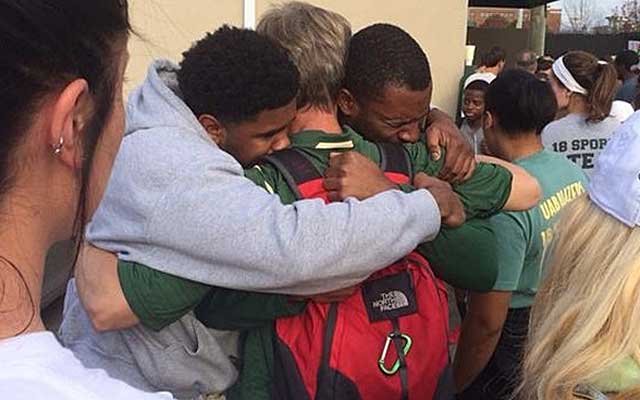
The uncertain future
This is what the death of a college football program looks like.
Football players must decide whether to continue on scholarship at their school or chase their dream elsewhere. Coaches and administrators wonder where they will work next. Athletes in other sports wait to find out their conference.
Watts believes UAB could still stay in Conference USA, whose current bylaws require football as part of being a member.
"We stayed in Conference USA a couple years ago when all the shuffling was going on," Watts said. "We stayed loyal to our conference. We're one of the original members. So we paid our dues and expect to be heard fairly. We're going to contribute as much or more than any of the other institutions will contribute to Conference USA."
Left unspoken is UAB had nowhere to go in conference realignment with a football program that had not invested in itself as much as others. Few people think C-USA will change its bylaws to keep UAB.
C-USA commissioner Britton Banowsky said in a statement the league is "disappointed with the decision to discontinue the sport of football at UAB, particularly because of its effect on the lives of the student-athletes and coaches that have worked so hard to restore the quality of the program. We don't fully understand the decision, nor agree with it, but do respect it and the authority of the UAB Administration to make it."
Standing with the crowd of protesters outside the football building, UAB baseball player Mitch Williams wondered what this decision means for him.
"A lot of guys came here because of Conference USA and the quality of competition they have," Williams said. "That’s going to be a big downer for us, as well as funding could go down. The biggest thing is we don't have any sure answers."
UAB will honor scholarships to the athletes whose sports got cut. That doesn't matter to starting offensive lineman Cameron Blankenship, who has one year left of eligibility.
"Football is my life," Blankenship said with tears in his eyes. "As much as it hurts, I couldn't just not play. Honestly, staying doesn't mean anything now. My brothers are gone. There's no more football. It's just very heartbreaking."
Ja'Won Arrington was a walk-on UAB football player who came from Alabama A&M and got put on scholarship by Clark.
"Now you’re telling me I've got two more years left to play and I've got to give up on football and settle for an education?" Arrington said. "Now an education is good and everything, but what about the dreams you have? You still want to accomplish them. It's just crazy."
Dusty Davis, the team chaplain, hugged UAB players as they left the team meeting with Watts, sometimes two at a time. Moments after leading a prayer with UAB protesters, Davis described himself as "violently angry" at the circumstances.
"A lot of these kids won't get other opportunities," Davis said. "They might be able to drop down and play at other schools. A lot of these guys will be working fast food or back in their hometown living with mom or grandma. That's the cold reality."
Across the continent on Tuesday, Chris Pond could relate to what was happening in Birmingham. Pond is head athletic trainer at Pacific and was there on Dec. 19, 1995, when the university dropped football.
Unlike UAB, which had a month to deal with this likelihood, the news hit Pacific out of the blue. Nothing had been leaked. Students had gone home for winter break when Pacific announced it was suspending football.
"It's just pure devastation," Pond said. "You think your world's ended."
Looking back on it from his perspective, Pond believes the decision allowed the medical staff to meet the needs of more athletes who used to be intimidated to come in for treatment. "There's not a football-first mentality any longer," Pond said.
In the decade after football ended, Pacific's other teams won 16 more conference titles and made 10 more NCAA championship appearances than in the previous 16 years when it had football. The enrollment at the private university was 5,564 in 1995; today, it's 6,304.
And yet despite Pond's belief Pacific has thrived through the years, "it's painful on Saturdays not to have football," he said wistfully. "I think I will always miss football."
This is what the death of a college football program looks like.
The initial cut runs deep and causes great pain. The slow bleed lingers each fall.













